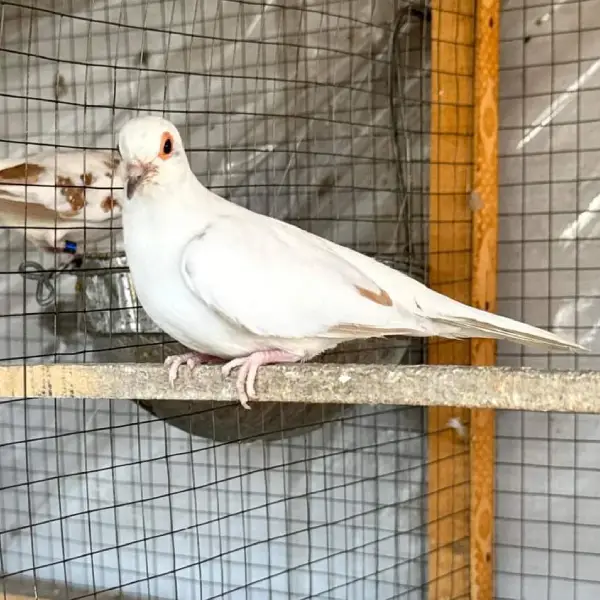Free shipping order over 20,000
African Grey
₨ 468,750 Original price was: ₨ 468,750.₨ 375,000Current price is: ₨ 375,000.
- Scientific Name: Psittacus erithacus
- Size: Typically 30-33 cm (12-13 inches) in length, with a wingspan of about 46-52 cm (18-20 inches).
- Weight: Around 400-600 grams (0.88-1.32 pounds).
- Color:
- Body: Predominantly grey feathers, with lighter grey on the head and darker grey on the wings.
- Tail: Bright red, which contrasts beautifully with the grey body. In the subspecies Psittacus erithacus timneh (Timneh African Grey), the tail is more maroon or dark brown.
- Eyes: Young African Greys have dark grey to black eyes, which gradually lighten to pale yellow as they mature.
- Beak: Large, strong, and black in color, well-adapted for cracking nuts and seeds.
- Feet: Zygodactyl feet (two toes facing forward and two backward) are grey and very dexterous, allowing the bird to grip branches and manipulate objects with ease.
Share
Share on facebook
Share on email
Important Keys:
Habitat
- Distribution: Native to the rainforests of West and Central Africa, with the Congo Basin being a significant habitat.
- Environment: Prefers dense forests, but can also be found in forest edges, gallery forests, and even in cultivated areas. They are arboreal and spend much of their time in the tree canopy.
- Social Structure: African Greys are highly social and are often seen in flocks, sometimes numbering in the hundreds. They form strong pair bonds and are very protective of their mates.
Diet
- Primary Food: In the wild, African Greys feed on a variety of seeds, nuts, fruits, and leafy vegetation. They have a particular affinity for palm nuts.
- Captivity Diet: A balanced diet for an African Grey in captivity includes high-quality pellets, a variety of fresh fruits and vegetables, and occasional nuts. Avoid feeding them chocolate, avocado, and foods high in salt or sugar.
- Feeding Behavior: They are highly intelligent and enjoy foraging activities. Offering them opportunities to work for their food through puzzle toys or hiding food in their cage is beneficial for their mental stimulation.
Breeding
- Breeding Season: In the wild, breeding typically occurs during the dry season when food is abundant.
- Nest Location: They nest in tree cavities, where the female will lay 3-5 eggs.
- Incubation Period: The female incubates the eggs for about 28-30 days, while the male provides food.
- Fledging: Chicks fledge around 10-12 weeks after hatching but are dependent on their parents for several more weeks.
Lifespan
- In the Wild: They can live around 40-50 years, though lifespan may vary depending on environmental conditions.
- In Captivity: With proper care, African Greys can live up to 60 years or more, making them a long-term commitment for pet owners.
Behavior
- Intelligence: African Greys are considered one of the most intelligent bird species, with cognitive abilities comparable to a 5-year-old human child. They can learn to mimic hundreds of words and phrases and can even understand the context of some of the things they say.
- Social Interaction: They are highly social birds that require regular interaction and mental stimulation. Without proper socialization, they can develop behavioral issues such as feather plucking or aggression.
- Vocalization: They are excellent mimics and can replicate a wide range of sounds, including human speech, household noises, and other animal calls. Their vocalizations are used for communication within their flock and can vary widely in tone and complexity.
![]()
Be the first to review “African Grey” Cancel reply
Related Products
-
-70%
Zebra Finch
₨ 5,000Original price was: ₨ 5,000.₨ 1,500Current price is: ₨ 1,500. -
-14%
Green Star Finch
₨ 17,500Original price was: ₨ 17,500.₨ 15,000Current price is: ₨ 15,000. -
-25%
Silver Gouldian Finch
₨ 24,000Original price was: ₨ 24,000.₨ 18,000Current price is: ₨ 18,000. -
-20%
Lotino Gouldian Finch
₨ 15,000Original price was: ₨ 15,000.₨ 12,000Current price is: ₨ 12,000. -
-13%
Gray Diamond Firetail Finch
₨ 23,000Original price was: ₨ 23,000.₨ 20,000Current price is: ₨ 20,000. -
-8%
Albino Cut-throat Finch
₨ 65,000Original price was: ₨ 65,000.₨ 60,000Current price is: ₨ 60,000. -
-20%
White Zebra Dove
₨ 43,750Original price was: ₨ 43,750.₨ 35,000Current price is: ₨ 35,000. -
-40%
Red Pied Dove
₨ 10,000Original price was: ₨ 10,000.₨ 6,000Current price is: ₨ 6,000.
Sign Up for Exclusive Birds Care Tips and Offers from Phool Panchi
Company links
Category
Contact
© 2024 Phool Panchi | Developed By v3Studio
















Reviews
There are no reviews yet.